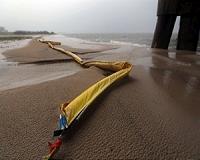| . |  |
. |
New Orleans, Louisiana (AFP) May 9, 2010 In the ongoing Battle of the Gulf of Mexico, the "enemy" is a gushing oil slick, fought miles from the Louisiana coast with skimming boats, controlled burns, and - amid increasing doubts -- chemical dispersants. Rough weather last week hampered efforts to skim the oil from the sea with boats and controlled burns, but calmer waters have brought the battle back to the Gulf. Officials are also spraying chemical dispersants over the slick to break it up, producing an effect likened to dish washing liquid. "It's really designed to break down the oil," said Bob Perciasepe, deputy administrator of the Environmental Protection Agency (EPA). "It does not make the oil disappear but it makes it into smaller and smaller particles that makes easier over the long haul to be biodegradable instead of big... really, oily globs." On Saturday, three top Louisiana officials from the departments of health, environmental quality, and wildlife & fisheries published a letter to British Petroleum CEO Tony Hayward - requesting more information on the chemical dispersants. "We have serious concerns about the lack of information related to the use of dispersants in fighting the oil spill at and below the surface of the Gulf of Mexico, and what, if any, impact the dispersants could have on our people, water and air quality, as well as the wildlife, fisheries and vegetation of Louisiana's coastline and wetlands," the state secretaries wrote on May 7. Also, National Wildlife Federation, US environmental groups and Gulf Coast shrimpers last week raised concerns about the potential damage to marine life from both the leaking oil and chemical dispersants. "The increasing use of dispersant has left a number of questions about where this material is moving to," said NWF chief Larry Schweiger. Pending test results, the Environmental Protection Agency on Thursday announced a halt to BP's unprecedented, underwater use of chemical dispersants near the leaking well source -- almost a mile down (1.6 kilometers) in the chilly Gulf waters. Huge C-130 cargo planes continued spraying chemical dispersants Saturday, carpeting vast swaths of the oil slick below. Forty-one percent of seafood consumed in the United States comes from offshore and coastal Louisiana, Subra said, citing figures from the state Department of Wildlife & Fisheries. Skimming is only effective when seas are one-to-three feet, BP officials have acknowledged. Controlled burning is limited to smaller, heavy concentrations of oil further south in the Gulf. Dispersant can be sprayed at any time other than when planes can't fly, Subra says, adding that chemical dispersants are more successful with smaller spills of a fixed amount. "But with this [Gulf] spill they have to keep applying it because the source is still there," she said. The underwater well has been gushing an estimated 5,000 barrels of medium crude oil daily since the Deepwater Horizon sank April 22 - two days after fiery explosion left 11 crewmembers dead. LuAnn White, a toxicologist at Tulane University, said chemical dispersants have been used on oil spills for years, including the notorious Exxon Valdez disaster in Alaska in 1989. "What's out now is a new generation of dispersants, but we don't know what is in them because it's a trade secret,' White said. NALCO Energy Services of Sugar Land, Texas, manufactures the chemical dispersant for BP, which is known by its product name "Corexit." The dispersant itself is a low-level hazardous chemical, posing risks for eye and skin irritations and "chemical pneumonia" but not cancer, according to NALCO data posted on the Deepwater Horizon web site. "Chemical dispersants -- I come down on the pro' side," said Eric Smith, associate director of the Tulane Energy Institute, a finance professor and oil & gas marketing analyst. "You are talking about a very thin dispersant. Ideally, you want to use skimmers on the heavy oil areas and dispersants on the wider sheen (of the spill)." Rough seas are bad for skimmers but good for mixing the surface oil with dispersant - "which is like washing your hands with soap," Smith said. Smith adds that the good news is that the spill oil is a "light sweet crude" which is easier to clean up and results in less damage than heavier crude oils. "You may have environmental damage for a short time," Smith said, "but with this kind of crude oil, it's going to be gone in six months to a year -- if they (BP and authorities) are sticking to spraying the sheen."
Share This Article With Planet Earth
Related Links Our Polluted World and Cleaning It Up
 Louisiana begs for more boom as oil slick laps coastal islands
Louisiana begs for more boom as oil slick laps coastal islandsHopedale, Louisiana (AFP) May 7, 2010 Louisiana begged for more protective booms and urged the federal government not to repeat the mistakes of Hurricane Katrina Friday as a massive oil slick lapped coastal islands. More than two weeks after a BP-leased rig sank spectacularly 50 miles offshore and started hemorrhaging an estimated 200,000 gallons of oil a day into the Gulf of Mexico on April 22, vast swaths of the US coast remai ... read more |
|
| The content herein, unless otherwise known to be public domain, are Copyright 1995-2010 - SpaceDaily. AFP and UPI Wire Stories are copyright Agence France-Presse and United Press International. ESA Portal Reports are copyright European Space Agency. All NASA sourced material is public domain. Additional copyrights may apply in whole or part to other bona fide parties. Advertising does not imply endorsement,agreement or approval of any opinions, statements or information provided by SpaceDaily on any Web page published or hosted by SpaceDaily. Privacy Statement |